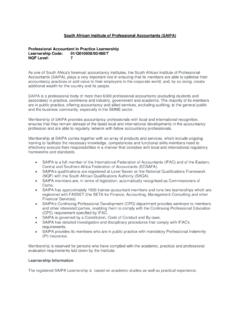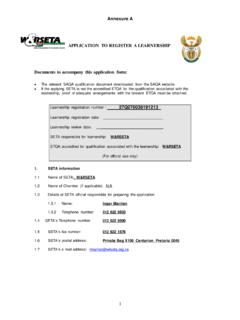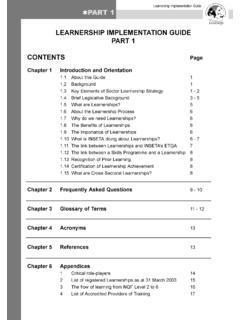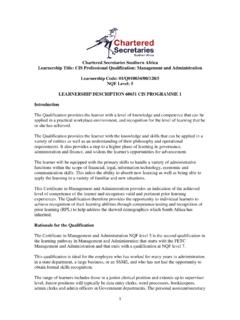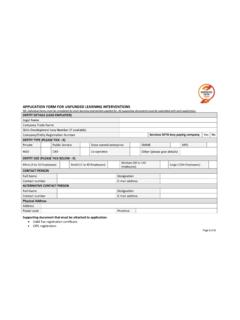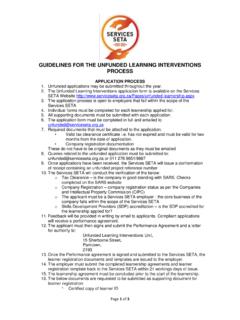Transcription of LEARNERSHIP IMPLEMENTATION PROCESS 10 steps - …
1 LEARNERSHIP IMPLEMENTATION PROCESS - 10 steps . Diagram of the 10- step IMPLEMENTATION PROCESS Introduction to step 1. The importance of planning LEARNERSHIP IMPLEMENTATION Before you take the first step on your journey, it would be worth considering the importance of carefully planning your organisation's involvement in Learnerships, to avoid the pitfalls of poor planning. The success of LEARNERSHIP IMPLEMENTATION depends largely on a thorough planning of the organisation's involvement in Learnerships and an understanding of the issues raised in step 1. It is for this reason that the first step in the LEARNERSHIP IMPLEMENTATION PROCESS is dealt with quite comprehensively. Implementing Learnerships is a costly and time-consuming PROCESS , and therefore it is important that the PROCESS be carefully planned. In addition, LEARNERSHIP actions must be driven by people who have a thorough understanding of what is required to make it a success.
2 Negative impact of poorly planned IMPLEMENTATION When Learnerships were first introduced into workplaces, around 2001-2002, many organisations that enthusiastically embraced this new system burnt their fingers because they had not planned the IMPLEMENTATION thoroughly. Unfortunately, many were driven by SETA promises of substantial financial reward for implementing Learnerships, rather than by a clear plan for using Learnerships to address critical skills development needs in their organisations. This has had many negative results, the Learnerships did not achieve the intended objectives, the PROCESS was disorderly and caused much confusion (especially in the workplace), and, most importantly, the problems experienced created resistance to Learnerships in general. step 1: INITIATE LEARNERSHIP IMPLEMENTATION . FORMULATE THE ORGANISATION'S STRATEGY ON.
3 LEARNERSHIPS, OR REVIEW EXISTING STRATEGY. INITIATE YOUR ORGANISATION'S INVOLVEMENT IN. LEARNERSHIPS. A good starting point to complete step 1 is to initiate a discussion in your organisation on its involvement in Learnerships. If your organisation is already involved in Learnerships, this action should be directed towards evaluating the current involvement. This is generally initiated by an individual or group of people from the departments/units responsible for Human Resource Development (HRD), skills development or training. In companies this would probably be the HRD or Training Manager, Skills Development Facilitator (SDF) or Training Committee. In training institutions this could be the senior manager responsible for curriculum planning. It could also be any person who acts as a LEARNERSHIP champion and takes the initiative in promoting the organisation's involvement in Learnerships.
4 This document is designed to record the information that will assist you in planning your organisation's strategy for implementing Learnerships. You should adapt it to suit the particular needs of your organisation. Large organisations planning extensive involvement in Learnerships may need a comprehensive document, while small organisations may only need to record some of the points. Use the template of the Strategy for LEARNERSHIP IMPLEMENTATION which is provided in this publication, or develop your own document on the basis of the template. The index to the template gives an overview of the type of information that is included in this document. Annexure: STRATEGY FOR LEARNERSHIP IMPLEMENTATION . Please note that this template is an example that has been developed to assist you to make a success of your LEARNERSHIP IMPLEMENTATION .
5 The form itself is not an official SASSETA. requirement. DETERMINE THE NATURE OF LEARNERSHIPS AND SKILLS. PROGRAMMES. Before your organisation gets involved in Learnerships it is vital to ensure that all interested parties have an accurate understanding of what a LEARNERSHIP is. For those driving the planning and IMPLEMENTATION of Learnerships, it is imperative to have a clear understanding of the key features of a LEARNERSHIP and what is involved in its IMPLEMENTATION . Further characteristics of a LEARNERSHIP are provided in the Skills Development Act (1998), while the Regulations to the SAQA Act describe the characteristics of the qualification that the LEARNERSHIP is designed to achieve. Identify the legal requirements relevant to LEARNERSHIP IMPLEMENTATION In view of its commitment to the development of the people of South Africa, the Government introduced a series of acts and regulations to create an integrated skills development system aimed at promoting economic and employment growth and social development.
6 The main acts and regulations are listed below: The Skills Development Act, 1998 (Act No. 97 of 1998. The Skills Development Amendment Act, 2003 (Act No. 31 of 2003). The Skills Development Levies Act, 1999 (Act No. 9 of 1999). The Skills Development Regulations, No. R. 571 of 22 June 2001. The Regulations concerning the registration of intended Learnerships and LEARNERSHIP Agreements, No. R. 330, dated 3 April 2001. The Sectoral Determination No. 5: Learnerships, of the Basic Conditions of Employment Act 75 of 1997. The South African Qualifications Authority Act, 1995 (Act No. 58 of 1995 that established the National Qualifications Framework (NQF), and The Employment Equity Act, 1998 (Act No. 55 of 1998). Identify the benefits of implementing Learnerships in your organisation Learnerships are designed specifically to benefit employed and unemployed people, employers, as well as the economy and the broader nation.))
7 Learners need learnerships because they cannot afford the loss of income that full-time study would incur and many are not able to finance full-time study. They need learning programmes that are directly and practically related to their field of work and that will provide a foundation for further learning. Employed staff will gain new skills and knowledge that will increase their productivity and quality of work. Learnerships will also provide a career path and opportunities for further learning. The national qualifications achieved through learnerships will be recognised everywhere in South Africa and will help staff when they apply for a new job. Unemployed people need learnerships because they provide an opportunity to gain knowledge and work-based experience, which will make them employable or able to initiate self-employment opportunities.
8 They will be given employment for the duration of the LEARNERSHIP and be provided with opportunities to learn and gain workplace experience and skills. This experience will help them when they apply for a job or want to create their own job opportunities. Employers need learnerships because they need qualified staff and cannot afford to lose employees for long periods of training during off-site learning programmes. Identify the differences between Learnerships and other types of learning processes It is important to understand the differences and similarities between Learnerships and other types of learning programmes. This will assist in identifying where existing training processes could be used in implementing Learnerships and where unique processes need to be developed. The difference between Learnerships and apprenticeships Learnerships are similar to apprenticeships, in that they are both work-based routes to learning.
9 Both combine theoretical learning components with practical workplace application. In some cases existing apprenticeships have been used as the basis from which to develop Learnerships. Although they are similar, there are important differences between apprenticeships and Learnerships. Learnerships will replace the apprenticeship system, as the Department of Labour and the SETAs favour the LEARNERSHIP system. Existing apprenticeships will continue for the duration of their contract period. Example: A learner can complete a skills programme for install glass panes for windows and sliding doors , then do one in tiling , followed by one in laying paving . Together these and other skills programmes could enable the learner to achieve a national qualification in construction ESTABLISH THE LINK BETWEEN THE STRATEGY FOR. LEARNERSHIP IMPLEMENTATION AND YOUR ORGANISATION'S.
10 PEOPLE-DEVELOPMENT STRATEGY. Link the Strategy for LEARNERSHIP IMPLEMENTATION to your organisation's people-development strategy Learnerships are one of the many tools you can use to develop the skills your organisation requires and they should not be implemented in isolation from other learning and people- development interventions. Therefore, it is important to ensure that Learnerships are integrated into the overall skills-planning strategy and processes (WSP). Study the steps of the skills planning strategy described by Prof Ian Bellis to identify the links between this PROCESS and Learnerships. The main steps , taken from Skills development planning for improved performance by Bellis and Hattingh (2003: 4), are indicted in the figure below. (Training Committees). You could describe the links with the Skills Levy, Workplace Skills Plan (WSP) and Employment Equity Plan, as well as other initiatives such as existing mentorship programmes.


